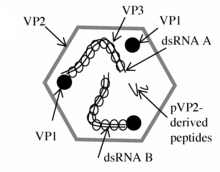Birnaviridae
| Birnaviridae | |
|---|---|

| |
Infectious bursal disease virus particle
| |
| Virus classification | |
| (unranked): | Virus |
| Realm: | Riboviria |
| Kingdom: | Orthornavirae |
| Phylum: | incertae sedis |
| Family: | Birnaviridae |
Birnaviridae is a family of double-stranded RNA viruses.[1] Salmonid fish, birds and insects serve as natural hosts. There are currently 11 species in this family, divided among seven genera.[2] Diseases associated with this family include infectious pancreatic necrosis in salmonid fish, which causes significant losses to the aquaculture industry, with chronic infection in adult salmonid fish and acute viral disease in young salmonid fish.[2][3]
Structure
Viruses in family Birnaviridae are non-enveloped, with icosahedral single-shelled geometries, and T=13 symmetry. The diameter is around 70 nm.[2][3]
Genome

The genome is composed of linear, bi-segmented, double-stranded RNA. It is around 5.9–6.9 kbp in length and codes for five to six proteins. Birnaviruses encode the following proteins:
The large RNA segment, segment A, of birnaviruses codes for a polyprotein (N-VP2-VP4-VP3-C) [5] that is processed into the major structural proteins of the virion: VP2, VP3 (a minor structural component of the virus), and into the putative protease VP4.[5] VP4 protein is involved in generating VP2 and VP3.[5] recombinant VP3 is more immunogenic than recombinant VP2.[6]
Non
Viral Replication
Viral replication is cytoplasmic. Entry into the host cell is achieved by cell receptor endocytosis. Replication follows the double-stranded RNA virus replication model in the cytoplasm. Double-stranded RNA virus transcription is the method of transcription in cytoplasm. The virus is released by budding. Salmonid fish (Aquabirnavirus), young sexually immature chickens (Avibirnavirus), insects (Entomobirnavirus), and blotched snakehead fish (Blosnavirus) as the natural host. Transmission routes are contact.[2][3]
Taxonomy

The following genera are recognized:
